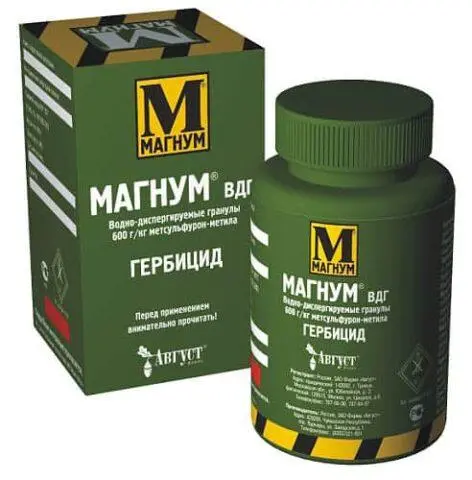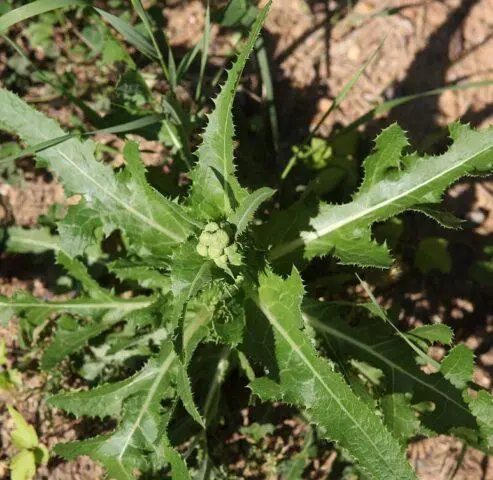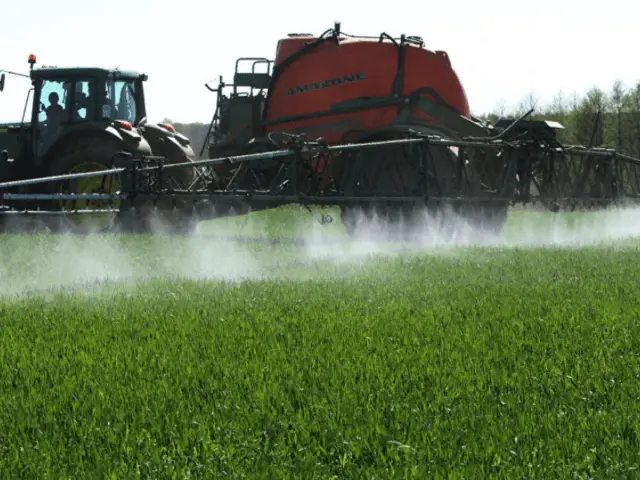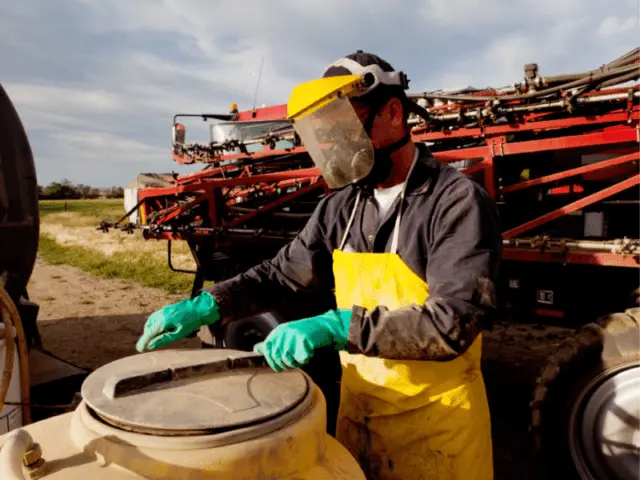Contents
- Composition and form of release
- Operating principle
- Advantages and disadvantages
- Preparation of working solution
- Instructions for use of the drug Magnum from weeds
- Compatibility with other means
- Safety Precautions
- Analogues
- Conditions and shelf life
- Conclusion
- Reviews of buyers of herbicide Magnum against weeds
Herbicide Magnum is a selective systemic drug used to kill annual and some types of perennial weeds in fiber flax and grain crops. The high efficiency of the chemical makes it advisable to use it to free virgin lands and non-agricultural areas from unwanted vegetation.

For the destruction of weeds in a field with grain, a single treatment with Magnum herbicide is enough
Composition and form of release
The active ingredient in Magnum herbicide is metsulfuron-methyl, which belongs to the class of sulfonylurea. The content of the active ingredient in the finished product is 60%.
Manufacturers of pesticides offer farmers another herbicide called Magnum Super, which includes metsulfin-methyl (30%) and tribenuron-methyl (45%).
The drug is produced in the form of water-soluble granules packed in 100 g plastic bottles.
The manufacturer of Magnum and Magnum Super is the company “August”.

The herbicide is available in an easy-to-use package.
Operating principle
Penetrating through the foliage and roots into plant cells, the active component of the herbicide Magnum VDG inhibits the formation of substances necessary for DNA biosynthesis and stops cell division.
Under the influence of the drug:
- the growth of the green mass of plants and the development of the root system stops;
- flower buds do not open;
- the ground parts of the weeds acquire an anthocyanin hue, that is, they become pink-red;
- the veins on the leaves become discolored;
- tops of weeds dry up;
- development of chlorosis and tissue necrosis is observed.
The first results of herbicide exposure can be seen a couple of days after treatment, and the complete death of weeds occurs within 1-3 weeks.
Herbicide Magnum acts throughout the entire growing season of cultivated plants.

Contact with herbicide on vegetable crops will lead to their death.
Advantages and disadvantages
One of the main advantages of the herbicide Magnum VDG against weeds, which has received many positive reviews, is that it does not adversely affect the growth and development of cereals and flax, affecting only weeds.

Magnum will cope even with difficult-to-hatch thistles
Pros:
- high efficiency;
- selective action (works exclusively on weeds);
- rapid clearance of non-agricultural areas;
- economy of the drug;
- a wide range of actions;
- the possibility of using cultivated plants during the growing season;
- affordable price and convenient form of release.
Cons:
- destructive effect on vegetable crops, sunflower and buckwheat;
- the appearance of resistance with prolonged use;
- long half-life on alkaline soils;
- the need for deep plowing of the soil after using the herbicide;
- introduction of restrictions in crop rotation;
- the impossibility of spraying by air in the vicinity of reservoirs with fish and fields with vegetable crops.
Preparation of working solution
Preparation of a working solution is not particularly difficult.
During work:
- the amount of Magnum herbicide indicated in the instructions is poured with a small amount of water;
- stir the composition until the granules are completely dissolved;
- half fill the sprayer tank with water and turn on the agitator;
- while continuously stirring, add the prepared mother liquor;
- add water to the desired volume.
The working solution is ready for use.

The fields are cultivated with a tractor
Instructions for use of the drug Magnum from weeds
Magnum herbicide is used to kill weeds in early spring or during their active growth.
Processing the fields with this drug helps to get rid of:
- ragweed wormwood;
- common warthog;
- hogweed;
- field bodyak;
- Veronica ivy;
- sowing vetch;
- tender geranium;
- different types of highlander;
- field mustard;
- walker;
- jaundice;
- asterisks;
- field cabbage;
- stinging nettle;
- common godson;
- buttercup field;
- swans;
- mother and stepmother;
- dandelion;
- thistle;
- plantain;
- wormwood;
- shepherd’s bag;
- pikulnik;
- weed sunflower;
- field chamomile;
- wild radish and other weeds.
The rate of herbicide use for the treatment of spring and winter grain crops, as well as fiber flax, is 8-10 g/ha. To clean weeds from non-agricultural lands (roadsides, security power lines, railway embankments, airfields, etc.), the consumption of the drug is increased to 50-300 g/ha.
When spraying 1 ha using ground transport, you will have to spend 200-300 liters of working solution. Aerial processing of fields makes it possible to reduce the consumption of the finished product to 50 l/ha.
The drug can be used in any weather, however, with high humidity, the processing efficiency increases.
After the application of Magnum herbicide on the treated fields, it is impossible to sow vegetables and legumes, root crops, sunflower and buckwheat the next year without preliminary deep plowing.

It is necessary to process the fields in accordance with the instructions for using the herbicide.
It is necessary to process the fields in accordance with the instructions for using the herbicide.
Compatibility with other means
Experts allow the combination of Magnum herbicide with other drugs in the process of preparing tank mixes. In some cases, this helps to improve the effectiveness of the agrochemical and expand its spectrum of action.
Herbicides Demetra, Ballerina, Zernomax, Gerbitoks can become suitable companions for Magnum in the process of processing crops. To protect against weeds of fiber flax, the drug is combined with Gerbitox, Lontrel-300 or Miura.
To destroy vegetation on non-agricultural facilities, a solution prepared from equal parts of Magnum and Tornado will help.
It is not recommended to mix the herbicide with organophosphorus insecticides, and also to treat crops with insecticidal preparations earlier than two weeks after treatment with Magnum.
Attention! In the process of preparing the working solution, Magnum is poured into the sprayer tank first.
Safety Precautions
Despite the fact that Magnum herbicide is not toxic to humans and warm-blooded animals, certain safety rules should be observed when working with it.
Experts recommend:
- Work with the drug no more than once every three days.
- Do not allow the chemical to come into contact with exposed areas of the body and mucous membranes. To do this, use closed clothing and high shoes, a respirator and goggles.
- Spray the fields in not too hot, calm weather (under the influence of active sunlight, the effectiveness of the herbicide may decrease).
- Do not use the drug in close proximity to stocked reservoirs and plantings of sunflower, buckwheat and vegetable crops.
- After work, take a shower and wash your work clothes.
- Dispose of the unused solution (pour into the sewer).
- In case of contact with the mucous membranes of the eyes or mouth, immediately rinse them with plenty of running water.

There are special protective equipment for working with pesticides.
Analogues
As analogues of Magnum, selective herbicides can be used, the active substance of which is metsulfuron-methyl. The most common today are Terramet, Laren Pro, Grench.
Conditions and shelf life
In unopened original packaging, Magnum herbicide retains its beneficial properties for five years. The chemical should be stored in a special, dry, cool room isolated from food and medicines at a temperature of +5-25 °C.

The working solution must be used on the day of preparation.
Conclusion
Herbicide Magnum is an effective drug that will help destroy weeds and will not harm cultivated plants. In order for the treatment to provide a good result, it must be carried out in strict accordance with the instructions for use of the drug.









